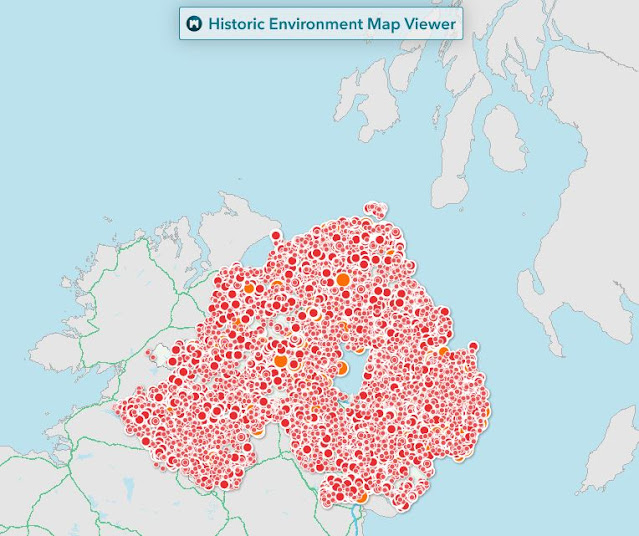Truly Ancient
As you can see from the map above, we aren't short of archaeological sites in this part of the world. There are the three spectacular tombs in the Boyne valley, Newgrange, Knowth and Dowth, (Brú na Bóinne Visitor Centre: Newgrange, Knowth and Dowth | Heritage Ireland). The huge Giants Ring in Belfast, (Giant's Ring | Department for Communities (communities-ni.gov.uk)). Maeve's grave in Co. Sligo, (Queen Maeve Trail – Knocknarea – Sligo Walks. There are thousands of others too including, as below, the stone circle at Ballynoe, about 5 miles outside Downpatrick (Ballynoe ‘Stone Circle’ | Department for Communities (communities-ni.gov.uk)).
It dates from the Neolithic to the bronze age, so from about 4000 years ago, and has links to the Boyne Valley monuments as well as to one other local site at Millen Bay near Portaferry, at the southern tip of the Ards Peninsula. You will see why I have mentioned this here before the end of this article.
Even getting to Ballynoe is an adventure. There is no car park, so you will have to park in the village, which was once a stop on the railway line to Downpatrick. Access is by single track roads, and there are no passing places other than house and field entrances, so if you are going here, take your time or you are likely only to find yourself embedded in the front of a tractor! The village still boasts a small pub that would have served commuters on the railway line. Walk uphill, and on the left, at the outskirts of the village is the entrance to the bronze age site.
Even walking to it sets the mood, since the old and narrow dry stone walled path is covered in arched gorse and Hawthorn. Hawthorne of course is linked to the folk tales about Irish fairies and other little people, (no analogies are intended here with the current use of the term fairy!), so those who still manage to maintain a belief in such vague spiritual nonsense have left offerings, prayers, ribbons and other stuff in the cracks between the rocks and tied to the Hawthorne branches in profusion. There are a few old stiles built into the dry stone walls too. It all adds to the atmosphere for the few hundred yards or so of green tunnel before you get to the site itself. Then you walk out of this green enclosed walkway into a fairly large site. It is impressive, and I had it all to myself for well over an hour.
Many of the stones have small hollows in them. Archaeologists apparently refer to these as cups, but I suspect that many of the ones here are natural marks from the last ice age. The site was excavated in the 1930's by a Dutch archaeologist. He dug here in both 1937, and 1938, and had intended to come again in 1939, but other events got in the way. The dig seems to have concentrated on the mound that you can see in the centre of the stone circle, and a few burials were found. A complete report on the dig was never published, possibly because of that minor fact of WW2 getting in the way. His research is now being taken up by students from Queen's University, Belfast, and Newcastle University in England. The students want to use modern techniques like DNA and radiocarbon testing on the burial remains found in the 1930's.
I can find no record of any artwork being found on the stones at this site. Some carvings from this period can be magnificent, like the ones at Newgrange, some is less so, such as the example in the photo below from Ayrshire in Scotland.
When I was looking around some of the outlying stones at Ballynoe, I noticed one, right on the boundary with another field that has a design. It is definitely not of Newgrange quality, but is very symmetrical, so I cannot think of a way that it could be natural. The shape is something like a crudely drawn Christmas tree, with a circle on the top. It isn't very clear in the photo, so I have given you two versions of the photo, one with the design highlighted. Please let me know your thoughts on this. Since this is on a field boundary, it may be that recent grass cutting has revealed this design. It would be great to think that there are still things to be found hidden in plain site on ancient sites like this, but the design is so crude I am unsure as to it's origin. Natural or carved? What do you think?













Comments
Post a Comment
Feel free to leave a comment: I don't use or sell your data, and you will not receive any spam mail as a result.